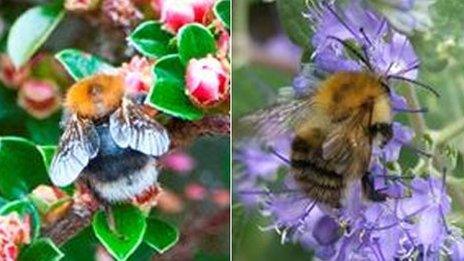First confirmed sighting of tree bumblebee in Scotland
- Published

The tree bumblebee (left) looks different from the common carder bumblebee
The first sighting has been confirmed in Scotland of a bee which arrived in England from mainland Europe in 2001.
The tree bumblebee was spotted last week by Bumblebee Conservation Trust member, David Taylor, in his garden in Lennoxtown, East Dunbartonshire.
The trust now wants to hear if the bee has been sighted in other areas.
Unlike most common domestic bees, tree bumblebees have a distinctive light brown thorax (middle segment), black abdomens and a distinctive white tip.
Mr Taylor said: "We've been keeping track of the bumblebees in our garden for a number of years.
"So, when we first saw this bumblebee on our cotoneaster, we knew it was different, and immediately got out our bumblebee chart to check.
'Exciting moment'
"We then tried to get a photo, but the bees are very active and very wary, so had to get help from our daughter, Claire, who eventually succeeded in getting a clear shot."
The Bumblebee Conservation Trust said the behaviour of the tree bee was "quite different" from native bees.
The new arrival in Scotland is "a big fan of nesting high above ground" in areas such as bird boxes.
Elaine O'Mahony, the trust's surveys officer, described the Taylor family sighting as "an exciting moment for bumblebee science".
"We expected to receive a record of the bumblebee in Scotland last summer but when no-one reported seeing it, we assumed that the poor weather had kept it away," she said.
"It is possible though that it only kept our recorders inside, meaning that the bee made it as far north as Lennoxtown before being spotted."
Ms O'Mahony said the trust would like to hear about any other Scottish sightings via its online BeeWatch photo survey tool, external.
She added: "This will help us to record whether there are other populations between Lennoxtown and the border or whether this is the only colony in Scotland so far."